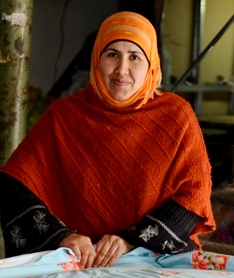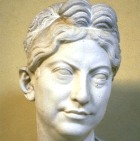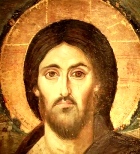Dorcas/Tabitha’s story
- Dorcas/Tabitha, an admired member of the early Christian community, has died of an unknown cause. Many people mourn her death.
- Her friends fetch Peter, hoping he can help.
- He comes, prays over her body in the upper room of the house and brings her back to life.
Who was Dorcas/Tabitha?
Read Acts 9:36-37
Tabitha seems to have been a well-off widow living in the coastal city of Joppa (to see the location of Joppa, go to Maps for the Life of Jesus – Palestine provinces).
The original Greek text describes this widow-woman as ‘mathetria‘, a female disciple – the only time the New Testament uses this word. So immediately we know she is a well-known woman of good repute.

Body in a shroud, with lilies
She is always portrayed in artworks and commentary as a holy woman, and that may well have been true. But she also sounds like one of those large-bosomed, generous-hearted women loved by all.
This is reinforced by the next thing we learn about her: she spends her time doing good works and ‘acts of charity’.
Dorcas/Tabitha dies
She becomes ill and dies. Her illness is unspecified, but we may assume she was nursed by her friends and family. There was nothing corresponding to a hospital or medical center at that time. Sick people were cared for in their own home, by their friends and family.
When she dies, her body is washed and cared for (see Burial Practices in the Ancient World) and then laid out in an upper room.
It was the women’s task to prepare a dead body for burial. The body was washed, and hair and nails were cut. Then it was gently wiped with a mixture of spices and wrapped in linen strips of various sizes and widths. While this was being done, prayers from the Scriptures were chanted. See Major Events: Death and Burial
Why is the ‘upper room’ mentioned?
It has special significance in the Christian story. An upper room was the scene of the Last Supper in Jerusalem, and it is mentioned twice, pointedly, in the story of Tabitha.
It is a space that is removed from the hurly-burly of the ground-floor courtyard and public rooms, a relatively quiet place where contact with God might take place.
Peter is summoned, and responds

Sign post pointing to Joppa (actually, Joppa in Texas; my apologies to the people of Joppa, Texas…)
Read Acts 9:38-39
Ritual mourning follows her death. She has many friends, and they all wish to show their respect and affection by openly grieving.
Mourning was not a restrained activity in the ancient Middle East. People showed their grief by wailing, crying, and tearing the upper part of their woven garment. The more noise, the more it showed the dead person was loved.
But then someone has an idea… The people in Tabitha’s house, described also as ‘disciples’, hear that the apostle Peter is in nearby Lydda. They send two men to get him – no doubt the widows of Tabitha’s circle of friends had many sons and nephews who could be sent on this errand.
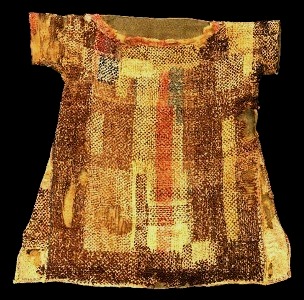
A child’s garment found by archaeologists south of Cairo. It was woven from coloured wools as a single piece of cloth folded over at the shoulders. It appears to have been darned for recycling. Clothing like this was made by Tabitha and her circle of friends.
Peter comes to Joppa
Peter responds immediately, and sets out. His journey is significant. It is a twelve-mile walk to Joppa, and by travelling there Peter is moving to the limits of Jewish territory – further away from Jerusalem, which at that time was hostile to the infant Christian church.
Is this an accident? No. The journey is a reflection of his inner journey, as he moves away from Judaism towards a new understanding of his mission.
Peter is taken to Tabitha’s body, laid out in the upper room of her house. Her friends are gathered around her body. They show Peter the garments she has made for the poor. The evidence for a well-lived life is there for all to see.
Peter raises Tabitha from the dead
Read Acts 9:40-42
Peter is moved by their grief, but he puts them outside so that the room becomes peaceful and quiet again. He is alone with the body of Tabitha.

Masolino’s fresco of the Raising of Tabitha,
Cappella Brancacci, Florence
He kneels and prays, facing away from the body – perhaps to focus his entire mind on God.
Then he turns to Tabitha’s body. Using her Jewish name, Tabitha, and drawing on the same source of power that Jesus had, he commands her to get up.
The dead body responds. She opens her eyes, sees Peter, and sits up. He extends his hand to her and raises her into a standing position.
Then he summons her friends from outside, to see with their own eyes what has happened.
Acts does not attempt to describe their gaping amazement. It simply records that because of this, many people believed in the Lord – as well they might!

But it is important to see that there are two dimensions to the raising of Tabitha:
- she is restored to life and
- she is returned to her friends and community.
The life of the body is one thing, but it must be accompanied by life within a community.
What is the impact on Peter?
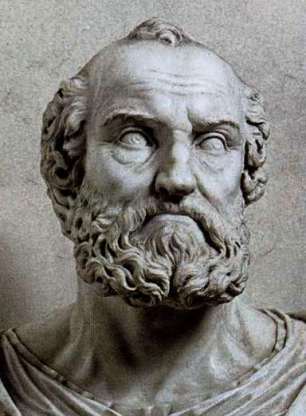
Bust of St Peter, by French sculptor Nicolas Cordier
Up until this moment, Peter believed it was his mission to convert the Jewish people.
At Joppa there is a significant change in his attitude. It is as if, after the raising of Dorcas, Peter realizes he has a more profound role to play in human history.
Acts 10 reports he had a dream and realized that ‘God shows no partiality’ (Acts 10:34).
From this moment, Peter knows he must convert Gentiles as well as Jews to belief in Jesus Christ.
This was one of Luke’s main points when he wrote the Acts of the Apostles; he was writing largely for Gentile Christians.
Why is the raising of Tabitha so important?
It is a pivotal moment in Peter’s life.
- He and the first Christians are inspired and heartened, and
- the infant Church spreads and grows because of this miracle.
What are the main ideas in Tabitha’s story?
…that women in the Christian communities, like Dorcas, were models of the traditional Roman virtues: good sense, modest behaviour, care for those less fortunate, and courage in the face of adversity.
Tabitha
- attended to her spinning, producing garments for the poor
- was a model to the community whose members revered her
- dedicated her time to good works.
Why was this image so important?

Church mosaic of four Christian women revered in the early Church
It showed that the early Christians were not undesirables whose practices included cannabilism (eating the body and blood of a leader called Jesus).
Moreover, the story of the raising of Tabitha established Peter as a miracle-worker who had inherited some of the power of Jesus. He was therefore worthy to lead the emerging Christian church.
Tabitha’s story is part of the dynamic growth that followed Pentacost.
Names in the story of Tabitha

Tabitha is a Jewish name meaning ‘gazelle’
Tabitha is a Jewish name meaning ‘gazelle’. Dorcas is Greek, and also means ‘gazelle’.
Why does Luke, in the Acts of the Apostles, give both names? Many Jews living in the Diaspora (outside Judaea) had two names, one Jewish and one Greek or Latin. They saw themselves as part of the cosmopolitan Roman world, not just an off-shoot of Judaism.
Peter (Simon) means ‘rock’ or solid foundation.
Activities & questions
Empathic reconstruction
Imagine that you are present in the house of Dorcas when Peter raises her from the dead. Describe
- what happens when Dorcas dies
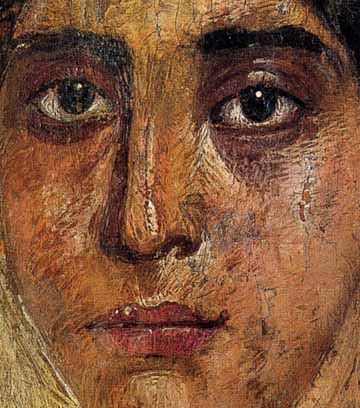
- Peter, how he looks, what he says and does
- the response of the crowd of people when Dorcas comes back to life
- your own emotions when you realize what has happened
- your thoughts a few days later, after you have considered the whole incident.
Present these descriptions and responses in the form of a journal entry, or assume the persona of a bystander and tell the group or a learning partner about your experience.
What happens after we die?
This is a question asked by every culture in every time.
Find out about the practices and beliefs surrounding death in 1st century Palestine. Spend some time thinking about your own beliefs about life after death.
Women in films
- Identify recent films that highlight the creativity of relationships between older women, either in a family situation or between friends.
- What methods has the film used to present the relationship?
- Has the relationship been favorable, unfavorable or both? Explain.
Focus questions for Tabitha’s story
1.What are the most interesting moments in the story? Why do these particular moments appeal to me?
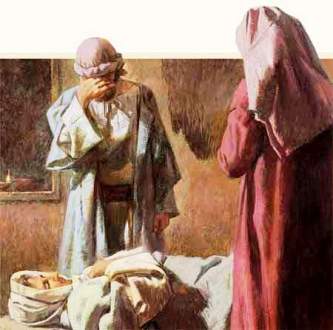
The disciples grieve over the dead body of Dorcas-Tabitha
2. In the story, who speaks and who listens? Who acts? Who gets what they want? If you were in the story, which person would you want to be friends with? Which person would you want to avoid?
3. What is God’s interaction with the main characters? What does this tell you about the narrator’s image of God? Do you agree with this image?
4. What is happening on either side of the story, in the chapters before and after it? Does this help you understand the meaning of the story?
For additional information on the lives of women in the Bible, see the links to
FAMILY, WORK AND RELIGION: the tribe, the family, slaves, women’s tasks, beliefs
MILESTONES IN A WOMAN’S LIFE: Puberty, menstruation, marriage, childbirth, death, burials
Dozens of extra ideas at
Activities for Bible Study Groups and Schools
Read about more fascinating women of the Bible
Search Box
![]()
Dorcas/Tabitha – Women of the New Testament, Bible Study Resource
Raising of Dorcas/Tabitha by Peter, apostle
Links for Dorcas – Tabitha
__________

Bible study ideas
See bottom of this page
© Copyright 2006
Elizabeth Fletcher

